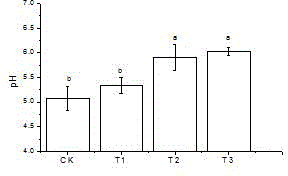Comprehensive repair method for residual quinclorac herbicide in tobacco field
A dichloroquine phosphoric acid and repair method technology, which is applied in the agricultural field, can solve the problems of little effect, achieve good effect, increase yield and quality, and reduce cost
- Summary
- Abstract
- Description
- Claims
- Application Information
AI Technical Summary
Problems solved by technology
Method used
Image
Examples
Embodiment example 1
[0026] Through the pot experiment in the greenhouse, after adding quinclorac (soil content reaches 1.50 mg / kg), different restoration measures CK1 (adding quinclorac, no restoration control), CK2 (no addition of quinclorac acid control), T1 (add 1% quicklime to the soil), T2 (add 1% straw biochar), T3 (1% quicklime + 1% straw biochar), T4 (1% quicklime + 1% Straw biochar + foliar spraying of gibberellin (10 mg / kg), potassium dihydrogen phosphate and mancozeb mixture (1000 times liquid), spraying twice at intervals of 7 days). The agronomic traits and biomass of tobacco in flat top stage were investigated, and the residual amount of quinclorac in soil was detected.
[0027] The results of the study showed that from the agronomic traits (Table 1), different restoration measures were helpful to the growth and development of tobacco, and increased the plant height, number of effective leaves and leaf area of three leaf positions, among which T4 treatment had the best effect, ba...
Embodiment example 2
[0035] In a typical tobacco-rice rotation area in Xuancheng, Anhui Province, a comparison experiment was carried out between this method and the conventional method on tobacco field soil with quinclorac residue (0.25 mg / kg residue). The test was divided into 4 treatments: no restoration (CK), agronomic restoration (T1), chemical restoration (T2) and the comprehensive restoration method described in the present invention (T3). Agronomic restoration is carried out by means of deep plowing, drying, irrigation and drainage, chemical restoration is improved by combining biochar with quicklime, and comprehensive restoration adopts the comprehensive restoration method of the present invention. Among them, deep plowing, sun-drying, intertillage depth 30 cm, irrigation and drainage twice. The chemical remediation method uses 1500 kg / hm of quicklime powder evenly spread on the soil surface 2 , straw biochar 1500 kg / hm 2 The improved method of the present invention combines soil surfac...
PUM
 Login to View More
Login to View More Abstract
Description
Claims
Application Information
 Login to View More
Login to View More - R&D
- Intellectual Property
- Life Sciences
- Materials
- Tech Scout
- Unparalleled Data Quality
- Higher Quality Content
- 60% Fewer Hallucinations
Browse by: Latest US Patents, China's latest patents, Technical Efficacy Thesaurus, Application Domain, Technology Topic, Popular Technical Reports.
© 2025 PatSnap. All rights reserved.Legal|Privacy policy|Modern Slavery Act Transparency Statement|Sitemap|About US| Contact US: help@patsnap.com



